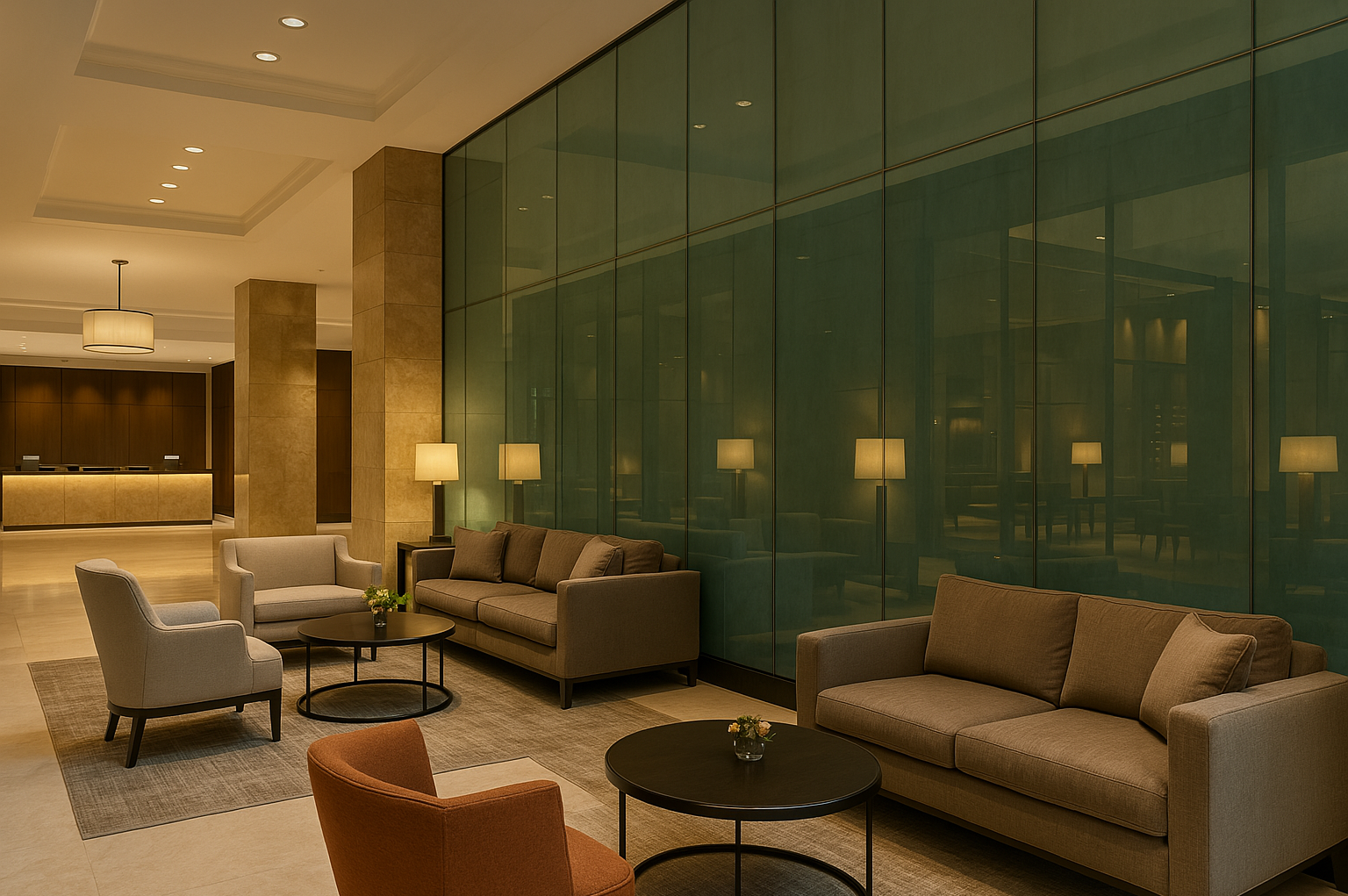
Glass wall cladding is redefining modern spaces, transforming interiors and exteriors with its durability, style, and ability to enhance natural light. More than just a design feature, it creates a sense of openness, maximizes space, and adds a contemporary finish. If you’re looking to upgrade an office, home, or commercial building, glass wall cladding offers a lasting and impactful solution.
In this guide, you’ll discover everything you need to know about glass wall cladding, its benefits, types, best applications, key maintenance tips, and other essential details to help you make the right choice for your project.
What Is Glass Wall Cladding and Why Is It Popular?
Glass wall cladding is the application of glass panels to cover walls, creating a refined and durable surface for both interior and exterior spaces. Unlike conventional materials such as wood, stone, or metal, glass offers a smooth and reflective finish that enhances spatial perception while allowing light to flow freely. It is engineered for strength, with options ranging from tempered and laminated glass to back-painted and frosted variations, each serving specific aesthetic and functional purposes.
Its growing popularity stems from its adaptability and efficiency. Unlike traditional cladding materials that may require frequent upkeep, glass resists moisture, stains, and wear, making it a low-maintenance yet high-impact choice. Painted surfaces may chip or fade over time, but glass maintains its pristine look with minimal maintenance. Additionally, its non-porous nature resists moisture and stains, making it an excellent option for kitchens, bathrooms, and high-traffic areas. Whether used as a striking feature wall, a sleek office partition, or a weather-resistant building façade, glass wall cladding combines strength and style in a way that few other materials can match.
What are the Different Types of Glass Wall Cladding?
1. Back painted glass cladding
Back painted glass cladding is an excellent choice for those looking to add a vibrant, colorful touch to their space. The glass is coated with paint on the back, creating a smooth, reflective surface that enhances both interiors and exteriors. This type of cladding allows for a wide range of custom colors, making it perfect for creating bold accents or vibrant feature walls. Whether used in a modern office or a stylish home, back painted glass adds a unique, eye-catching element to any design.
2. Exterior glass wall cladding
Exterior glass wall cladding is engineered to endure harsh weather conditions while delivering a modern, elegant look to building facades. This durable cladding offers protection against UV rays, rain, and pollutants, making it an ideal choice for buildings exposed to the elements. In addition to its resilience, exterior glass cladding also improves energy efficiency by regulating temperature and light. With its contemporary design, it enhances the architectural appeal of any structure while standing strong against the forces of nature.
3. Interior glass wall cladding
Interior glass wall cladding adds an element of elegance and sophistication to indoor spaces, while also offering practical benefits like easy maintenance. It is ideal for areas that see high traffic, such as corridors, lobbies, and meeting rooms, where both aesthetics and durability are key. The glossy surface of interior glass is simple to clean, resistant to stains, and contributes to a lighter, more open atmosphere. By reflecting natural light, it helps create a brighter, more inviting environment, perfect for elevating the interior design of any building.
4. Glass wall cladding panels
Glass wall cladding panels offer a modular solution for those seeking a streamlined, efficient installation process. These pre-fabricated panels come in a variety of finishes and sizes, allowing for flexible design options while ensuring a uniform, professional appearance. Perfect for both new construction and renovation projects, glass panels can be quickly assembled to create stunning facades or interior features. Their modular nature not only reduces installation time but also allows for easy customization, making them a versatile option for any design project.
How Does Glass Wall Cladding Enhance Your Space?
1. Adds a polished, high-end finish
Glass wall cladding instantly transforms any space by adding a sleek, modern aesthetic that exudes sophistication. The smooth, reflective surface brings a high-end, contemporary feel to both interiors and exteriors, effortlessly elevating the design of any building. Whether you’re aiming for an ultra-modern home or a chic commercial space, glass cladding provides a polished, stylish appearance that aligns with current architectural trends. Its minimalist design integrates seamlessly with various materials, creating a visually appealing contrast that enhances the overall ambiance of your environment.
2. Increases natural light and brightness
One of the most significant benefits of glass wall cladding is its ability to flood your space with natural light. The transparent nature of glass allows sunlight to enter freely, brightening up even the most dimly lit rooms. This increase in natural light creates a warm, inviting atmosphere while reducing the need for artificial lighting, making your space feel more open and airy. Additionally, the reflective properties of glass help bounce light throughout the room, further enhancing the sense of brightness and spaciousness in your environment.
3. Requires minimal effort for maximum longevity
Glass wall cladding is not only aesthetically pleasing but also highly durable and easy to maintain, making it a practical choice for both residential and commercial spaces. The glass is resistant to wear, weathering, and fading, ensuring it maintains its beauty over time. Cleaning and upkeep are simple, as the smooth surface prevents the accumulation of dirt and grime, requiring only occasional wiping to keep it looking pristine. This low-maintenance quality makes glass cladding an ideal option for high-traffic areas, providing long-lasting protection without compromising on style.
What Are the Best Applications for Glass Wall Cladding?
1. Office spaces and commercial buildings
In office spaces and commercial buildings, glass wall cladding serves as a strategic tool to enhance both the visual and functional aspects of the environment. It is not just about looks but about creating a work environment that fosters transparency and openness. By using glass cladding, companies can introduce a sense of connectivity between departments, encouraging collaboration and effective communication. It’s also an effective way to divide spaces without creating the sense of isolation that traditional walls might impose. The high durability of glass in these settings helps maintain the building’s integrity over time, requiring less upkeep than other materials, which is crucial for businesses aiming for long-term sustainability.
2. Kitchens and bathrooms
When applied in kitchens and bathrooms, glass wall cladding offers much more than a simple design element. It addresses the challenges of water exposure and high temperatures, providing a surface that is resistant to steam, heat, and moisture damage. Unlike traditional tile or stone, glass doesn’t stain or trap grease, making it easier to maintain a hygienic environment. Additionally, it’s an ideal material for enhancing smaller spaces in these rooms; by reflecting light and creating a continuous surface, glass can make compact areas feel more expansive. The non-porous nature of glass prevents the buildup of bacteria and mold, offering practical benefits in spaces that require strict cleanliness.
3. Hotel lobbies and luxury interiors
Glass wall cladding in hotel lobbies and luxury interiors goes beyond decorative use, it establishes a sensory experience that defines the brand and atmosphere of a property. It helps create distinct zones within large spaces without physically obstructing sightlines, allowing guests to experience the layout and design flow. The material’s ability to withstand wear and tear while maintaining a polished appearance is especially important in high-traffic areas like hotel lobbies. Moreover, glass cladding can be paired with specialized coatings or treatments to help with sound absorption or improve energy efficiency, directly impacting guest comfort and lowering operational costs.
4. Exterior facades for modern homes
For modern homes, glass wall cladding on exterior facades plays a crucial role in transforming the relationship between the interior and exterior. It offers a way to frame the home’s landscape while minimizing the impact on the natural surroundings. With its capacity to absorb and reflect heat, glass wall cladding can aid in managing temperature fluctuations within the home, improving energy consumption. Its resilience to environmental factors, such as wind and rain, means it requires less frequent maintenance compared to other facade materials, ultimately preserving the home’s exterior finish for years. For homeowners interested in long-term value, glass provides both an aesthetic and a functional investment, reducing future repair and replacement costs.
How to Choose the Right Glass Cladding for Your Project?
1. Consider the purpose and functionality
Start by defining the primary function of the glass in your project. Are you enhancing aesthetics, improving insulation, or creating privacy? The purpose determines the type of glass and performance features you’ll need, such as thermal resistance or light transmission. For instance, energy-efficient glass is ideal for reducing heating costs, while impact-resistant glass may be necessary for high-traffic or high-risk areas.
2. Evaluate the type of glass
Different types of glass offer unique benefits suited to specific needs. Tempered glass is ideal for durability, offering safety in areas prone to impacts. Laminated glass, on the other hand, provides added security by holding together in the event of breakage. For energy efficiency, Low-E glass reflects heat, minimizing the need for artificial cooling, while reflective glass can reduce glare and provide privacy.
3. Assess durability and maintenance needs
Glass cladding is often selected for its resilience, but its maintenance requirements should be considered. Some glass options are treated to resist stains, pollutants, or water damage, requiring less upkeep. High-traffic or exterior installations need glass that withstands the elements, while interior applications may prioritize ease of cleaning. Consider the long-term maintenance commitment based on the chosen glass’s exposure to wear, weather, and environmental factors.
4. Match the glass with your design aesthetic
The glass should align with the overall design vision of your project. Clear glass enhances transparency and modern design, while frosted or tinted glass offers a level of privacy and a softer aesthetic. Textured or back-painted glass introduces vibrant, artistic elements, and etched designs can add intricate detailing. Ensure the glass complements the other materials and finishes to create a cohesive visual experience.
5. Understand installation and structural requirements
Glass cladding requires specific installation methods to ensure stability and safety. Large panels may need reinforced framing or additional structural support to bear weight and prevent shifting. Understanding the building’s load-bearing capacity is key when selecting glass, particularly for facades or expansive installations. The installation process also impacts cost and timeline, so planning ahead is crucial for a smooth execution.
6. Review budget and cost-effectiveness
While glass cladding can enhance your project, it’s important to align your choice with the budget. High-performance glass comes at a higher upfront cost but can save on long-term energy bills and reduce maintenance. Budget-friendly options may be suitable for smaller installations, but they may lack the same durability or efficiency. Weigh initial costs against long-term benefits to find the best value for your project.
Installation & Maintenance: What Should You Know?
1. Professional vs. DIY installation
When deciding between professional or DIY installation for glass cladding, it’s important to consider both the complexity of the job and the required expertise. Professional installation ensures that the glass is securely mounted, adheres to building codes, and is properly sealed to avoid future leaks. While DIY installation might seem cost-effective, the process can be challenging, particularly with large or heavy panels, and improper installation could lead to safety hazards or structural issues. For peace of mind and long-term durability, hiring a professional installer is often the safer and more reliable option.
2. Cleaning and upkeep tips
Maintaining glass cladding requires a regular cleaning schedule to preserve its clarity and visual appeal. Use soft cloths or microfiber towels to avoid scratching the surface, and always opt for pH-neutral cleaners rather than harsh chemicals that could degrade the glass over time. For stubborn stains, a mix of warm water and mild dish soap can be effective without causing damage. In outdoor environments, consider rinsing off the glass periodically to remove dust, bird droppings, or other debris, especially in areas with high pollution levels to ensure the cladding remains pristine and functional.
3. Preventing scratches and damage
To keep your glass cladding looking flawless, it’s essential to take steps to prevent scratches and other damage. Avoid using abrasive cleaning tools, such as rough sponges or steel wool, which can leave marks on the surface. For exterior cladding, regular checks for loose debris or dirt buildup are crucial, as these can scratch the glass when exposed to wind or rain. Additionally, installing protective barriers or using glass with an anti-scratch coating can add an extra layer of defense, reducing the risk of damage from everyday wear and tear, and ensuring that your glass cladding remains as pristine as the day it was installed.
FAQs
Yes, glass wall cladding is highly durable when properly installed, designed to withstand the elements and resist wear and tear over time. It’s made from toughened or laminated glass, ensuring it can endure impacts, weather changes, and even high winds. However, its long-term durability depends on the quality of the material and proper maintenance, so regular checks and upkeep are essential to preserve its performance.
Glass wall cladding is an excellent choice for high-moisture areas like bathrooms, as it’s resistant to water, mold, and mildew. Unlike porous materials, glass does not absorb moisture, which makes it ideal for shower walls and backsplashes. The non-porous surface of glass cladding ensures that it’s easy to clean and maintain in damp environments, keeping bathrooms looking pristine and hygienic.
Cleaning glass wall cladding is straightforward with the right tools and cleaning solutions. Use a microfiber cloth or a soft sponge with a mild, pH-neutral cleaner to avoid damaging the surface. For routine maintenance, simply rinse the glass with water to remove dust and debris, and avoid using abrasive materials that could scratch the surface, ensuring it stays clear and free from streaks.
While glass wall cladding can be more expensive than traditional materials like wood or brick, it offers significant long-term value. The initial cost may be higher, but glass cladding provides durability, minimal maintenance, and aesthetic benefits that can reduce repair costs and improve energy efficiency. When comparing materials, it’s important to consider the durability, aesthetics, and performance of glass to determine its overall value in the context of your project.
Yes, glass wall cladding can improve energy efficiency, especially when using double-glazed or Low-E (low-emissivity) glass. These glass types reduce heat transfer, keeping interiors cooler in the summer and warmer in the winter. Additionally, the reflective properties of glass can help to control sunlight, reducing the need for artificial lighting during the day, and contributing to lower energy consumption in commercial and residential settings.













